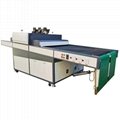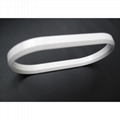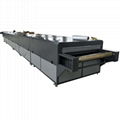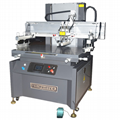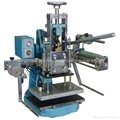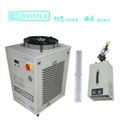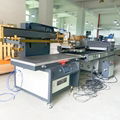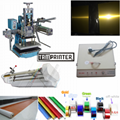| Model: | TM-D6090-T |
|---|---|
| Brand: | Tamprinter |
| Origin: | Made In China |
| Category: | Industrial Supplies / Plate Making & Printing Machine |
| Label: | fluted screen print , T-slot printer , T-slotscreen printer |
| Price: |
-
|
| Min. Order: | 1 SET |
| Last Online:11 Apr, 2025 |
TM-D6090-t Precision vertical plane screen printer
Technical parameter:
Common keys screen printing machine
|
Model No. |
TM-D2030-T |
TM-4060C-T |
TM-D4060-T |
TM-5070C-T |
TM-D5070-T |
TM-6090C-T |
TM-D6090-T |
|
Drive type |
X Common motor /Z Cylinder |
X /Z Cylinder |
X Common motor /Z Cylinder |
X /Z Cylinder |
X Common motor /Z Cylinder |
X /Z Cylinder |
X Common motor /Z Cylinder |
|
Printing area |
100X150mm |
400X600mm |
500X700mm |
600X900mm |
|||
|
Table size |
250X280mm |
500X700mm |
600X900mm |
700X1000mm |
|||
|
Max frame |
250X320mm |
650X720mm |
750X920mm |
800X1200mm |
|||
|
Printing thickness |
0~40mm |
0~40mm |
0~ 50mm |
0~ 50mm |
|||
|
Overlay accuracy |
0.05~0.08mm |
0.05~0.08mm |
0.05~0.08mm |
0.05~0.08mm |
|||
|
Platform precision |
About +/-0.04mm |
About +/-0.04mm |
About +/-0.06mm |
About +/-0.075mm |
|||
|
Printing pressure |
4.0-8.0 kgf/cm2 |
4.0-8.0 kgf/cm2 |
4.0-8.0 kgf/cm2 |
4.0-8.0 kgf/cm2 |
|||
|
Air pressure (mpa) |
0.5~0.6(Mpa) |
0.5~0.6(Mpa) |
0.5~0.6(Mpa) |
0.5~0.6(Mpa) |
|||
|
Air consumption |
35L/min |
35L/min |
35L/min |
35L/min |
|||
|
Printing speed |
1000pcs/h |
960pcs/h |
800pcs/h |
600pcs/h |
|||
|
Power |
220V/1.5KW |
380V/1.5KW |
380V/1.5KW |
380v /2.3kw |
|||
|
Dimensions (LXWXH)mm |
850X600X1350mm |
980X820X1580mm |
1330mmX1000mmX1750mm |
1500X1070X1750mm |
|||
|
Weight |
200kg |
280kg |
420kg |
480kg |
|||
video link:
http://v.youku.com/v_show/id_XOTIzNDU0Mzgw.html
Features:
1. The vertical structure, the screen rises and falls uses air operated perpendicular, about pad head slides the precise straight line guide rail and uses the frequency conversion motor-driven.
2. Uses the monolithic integrated circuit integration microcomputer control, the simplicity of operator facilitates.
3. The printing shaving knife reciprocating action uses the pneumatic control, the pressure size adjustable, about the traveling schedule uses the photoelectric control, according to screen size length adjustable.
4. Control panel with manual, semi-automatic, fully automatic three modes, printing and indirect time digital control.
5. The independent nose elevating gear, cleans the screen doctor blade, the oil discharge knife, when the para-position color printing is very convenient, prints the platform to be equipped with the X、Y、Z direction the fine trimming.
6. The net clamps the arm to use the double guide pillar form, the adjustment is convenient, and according to the printer area size, provides to the net installment.
There are three types of screen printing presses. The 'flat-bed' (probably the most widely used), 'cylinder', and 'rotary'.
Textile items are printed in multi-color designs using a wet on wet technique, while graphic items are allowed to dry between colors that are then printed with another screen and often in a different color.
The screen can be re-used after cleaning. However if the design is no longer needed, then the screen can be "reclaimed", that is cleared of all emulsion and used again. The reclaiming process involves removing the ink from the screen then spraying on stencil remover to remove all emulsion. Stencil removers come in the form of liquids, gels, or powders.
The powdered types have to be mixed with water before use, and so can be considered to belong to the liquid category. After applying the stencil remover the emulsion must be washed out using a pressure washer.
Most screens are ready for recoating at this stage, but sometimes screens will have to undergo a further step in the reclaiming process called dehazing. This additional step removes haze or "ghost images" left behind in the screen once the emulsion has been removed. Ghost images tend to faintly outline the open areas of previous stencils, hence the name. They are the result of ink residue trapped in the mesh, often in the knuckles of the mesh, those points where threads overlap.
While the public thinks of garments in conjunction with screenprinting, the technique is used on tens of thousands of items, decals, clock and watch faces, balloons and many more products. The technique has even been adapted for more advanced uses, such as laying down conductors and resistors in multi-layer circuits using thin ceramic layers as the substrate
Samples of Screen Printing Process
Photographic screens can reproduce images with a high level of detail, and can be reused for tens of thousands. The ease of producing transparent overlays from any black-and-white image makes this the most convenient method for artists who are not familiar with other printmaking techniques. Artists can obtain screens, frames, emulsion, and lights separately; there are also preassembled kits, which are especially popular for printing small items such as greeting cards.
Another advantage of screenprinting is that large quantities can be produced rapidly with new automatic presses (up to 1200 shirts in 1 hour.
hot tags: flash dryer screen printing
